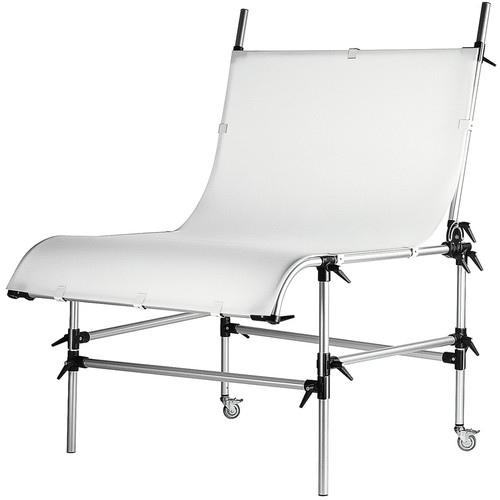My setup is kind of a poor-man's DIY version of something like this Manfrotto table. (You can click the picture for a link to the table on B&H Photo.)

Just like this table, my background is all white. The fade-to-black effect is achieved simply by making my light directional, so it does not hit the background.
Although I've perfected my technique mostly through my own experimentation, I'm not doing anything that isn't already well-known, so I don't really have any trade secrets to maintain.
If you want to achieve a similar effect, you will need to rig up some kind of modifier for your light that directs the light onto the product, and blocks it from hitting the background. It will also help to get the light very close to the subject, and farther from the background. To achieve the black background, you will want to have the light as far from the backdrop as possible.
And since you are using a constant light, instead of a flash, you will need to have the room completely dark, except for that light. Otherwise, the ambient light will probably show up in your photo.
And with that light, instead of a strobe, I would also recommend using a tripod since you will need to have a slower shutter speed in order to keep your ISO levels down, and have your aperture closed down to give some more depth of field and better sharpness.
Strobes are easier to work with since they provide such a bright light that it overpowers any ambient light, and doesn't require a tripod or slow-shutter speed.
Last edited by Edgar_in_Indy; 11-21-2015 at 02:37 PM.


 Similar Threads
Similar Threads 







 .
.





 ). Cut a rubber band into two pieces and make a discrete little trough to put the lens on. Or work with the slant and shoot downhill with something wedged behind the lens (make absolutely sure it can't roll of the table
). Cut a rubber band into two pieces and make a discrete little trough to put the lens on. Or work with the slant and shoot downhill with something wedged behind the lens (make absolutely sure it can't roll of the table ). Think of it like a large, beefed up version of the flash built into your camera (with a few other whiz bang features).
). Think of it like a large, beefed up version of the flash built into your camera (with a few other whiz bang features).



 Post #19 by Edgar_in_Indy
Post #19 by Edgar_in_Indy








